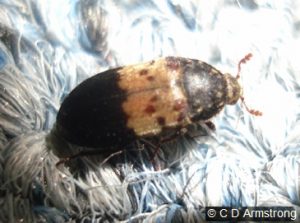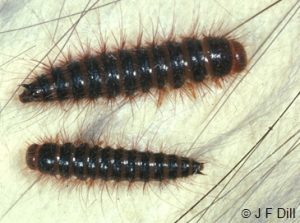Larder Beetles
Pest Management Fact Sheet #5026
James F. Dill, Pest Management Specialist
Clay A. Kirby (retired), Insect Diagnostician
Charles D. Armstrong, Cranberry Professional & Staff Entomologist
For information about UMaine Extension programs and resources, visit extension.umaine.edu.
Find more of our publications and books at extension.umaine.edu/publications/.
Description & Biology
Larder beetles–technically a type of carpet beetle–show a strong preference for meat or meat by-products for food. The larder beetle was named for the fact that it was historically found in larders (storage rooms), especially those used to keep cured meats before refrigeration was common. The word “larder” itself refers to a place for storing food, and the beetles were known for their preference for high-protein items like dried meats and other stored foods. However, larder beetles can survive on other organic materials, too. Infestations in homes most likely come from infested dry dog and cat food or bird feed. It is not unusual to find new infestations where rat or mouse baits have been used. The beetles can infest the baits and also the vermin carcasses. Mounted animals may also become infested. They will also feed on accumulations of dead cluster flies. Outdoors, they’ve even been observed preying upon spongy moth (Lymantria dispar) egg masses!
Grease from food preparation and cooking also attracts larder beetles. Any food that is not in a tight container, and has not been used for a month or more, should be checked for infestation whenever beetles or larvae are found.
The adult larder beetle is about 3/8-inch long, black, with a lighter band across the middle on which there are six small black spots. A full-grown larva is about 5/8-inch long, somewhat fuzzy, with two distinct spines on top of the back end that curve backward. When mature, the larvae can become even more destructive by chewing shallow holes into wood (in which they pupate).
- Larder Beetle Adult
- Larder Beetle Larvae
Management
Sanitation
To lessen the chances of larder beetle infestations, store food in glass, plastic or metal containers with tight-fitting lids.
The first step in controlling larder beetles is looking for the source of infestation. If you find an infested product or item, do not throw it away before destroying the infestation. To kill insects in a package that you intend to throw out, place the package in an oven at 125 to 140°F and heat for 30 minutes to fully penetrate the package. Other means of destroying the pests is to place the package in a freezer at -20°F for a week, or spray it with an insecticide. Only then should you discard the infested package. This will keep the pest from spreading.
Insecticides
There are several insecticides available to control larder beetles at home. To avoid confusion, it is best to purchase a brand that lists larder beetles or “general household pests”. Some options include cyfluthrin, tetramethrin, and permethrin. These are for crack and crevice treatment only and provide residual protection. There is no need to spray walls, ceilings or floors because the insects usually hide in cracks and crevices, or in food packages. Purchasing an aerosol spray can with a small 5-inch extension tube is handy for getting insecticides into cracks and crevices. Another approach is to apply the pesticide to corners and edges of storage areas with a small paintbrush.
A good job of vacuuming removes dust or debris from cracks or crevices, permitting better penetration of insecticides. The vacuum cleaner bag should be put into a plastic bag and sealed before disposal to prevent insects from spreading.
When Using Pesticides
ALWAYS FOLLOW LABEL DIRECTIONS!
Pest Management Unit
Cooperative Extension Diagnostic and Research Laboratory
17 Godfrey Drive, Orono, ME 04473
1.800.287.0279 (in Maine)
Information in this publication is provided purely for educational purposes. No responsibility is assumed for any problems associated with the use of products or services mentioned. No endorsement of products or companies is intended, nor is criticism of unnamed products or companies implied.
© 2016, 2018, 2020 | Reviewed/Revised: 2025
Call 800.287.0274 (in Maine), or 207.581.3188, for information on publications and program offerings from University of Maine Cooperative Extension, or visit extension.umaine.edu.
In complying with the letter and spirit of applicable laws and pursuing its own goals of diversity, the University of Maine System does not discriminate on the grounds of race, color, religion, sex, sexual orientation, transgender status, gender, gender identity or expression, ethnicity, national origin, citizenship status, familial status, ancestry, age, disability physical or mental, genetic information, or veterans or military status in employment, education, and all other programs and activities. The University provides reasonable accommodations to qualified individuals with disabilities upon request. The following person has been designated to handle inquiries regarding non-discrimination policies: Director of Equal Opportunity, 101 Boudreau Hall, University of Maine, Orono, ME 04469-5754, 207.581.1226, TTY 711 (Maine Relay System).



